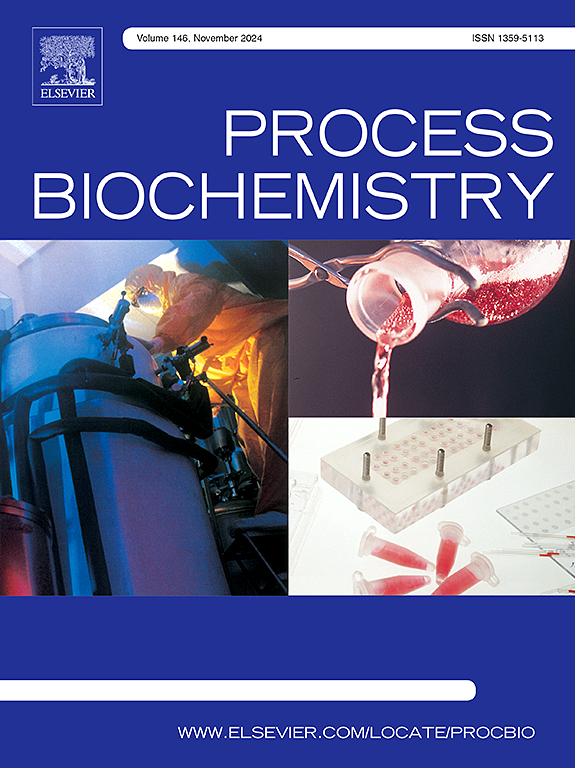在 3D 打印聚(乳酸)载体上共价固定葡萄糖淀粉酶,用于搅拌罐反应器中的淀粉水解
IF 3.7
3区 生物学
Q2 BIOCHEMISTRY & MOLECULAR BIOLOGY
引用次数: 0
摘要
本研究提出了一种新型的3d打印聚乳酸(PLA)载体,用于商用葡萄糖淀粉酶的共价固定。酶载体通过乙二胺(EDA)的氨解和戊二醛的活化进行功能化。由于使用戊二醛作为活化剂的共价固定化涉及形成固有不稳定的亚胺键,因此考虑在功能化步骤后使用硼氢化物作为还原剂来稳定这些亚胺键。在pH为10的条件下,用NaBH4固定化,酶活性最高(13.68 U g−1载体),固定化产率为32.80 % ± 0.51 %。可溶性酶的最佳活性条件为pH 4.92和50°C,固定化酶的最佳活性条件为pH 5.5和50°C。在连续10个反应周期(每个反应周期为10 min)下,对固定化葡萄糖淀粉酶的操作稳定性进行了评价,在第三个反应周期结束时,酶的活性保持在原来的65.19 %。固定化葡萄糖淀粉酶在搅拌槽反应器中糖化淀粉,12 h后转化率为95% %,第一次循环12 h后转化率为74 %。这些发现证明了PLA在葡萄糖淀粉酶固定化方面的潜力,为工业酶解过程中高效和可持续的淀粉水解提供了广阔的前景。本文章由计算机程序翻译,如有差异,请以英文原文为准。
Covalent immobilization of glucoamylase on 3D-printed poly(lactic acid) carriers for starch hydrolysis in stirred tank reactor
This study presents a novel 3D-printed poly(lactic acid) (PLA) carrier for the covalent immobilization of a commercial glucoamylase. Enzyme carriers were functionalized by aminolysis with ethylenediamine (EDA) and activated with glutaraldehyde. Since covalent immobilization using glutaraldehyde as activating agent involves the formation of imine bonds which are inherently unstable, the use of borohydride as a reducing agent to stabilize these imine bonds after the functionalization step was considered. The highest enzymatic activity (13.68 U g−1 carrier) was obtained when immobilization was performed at pH 10 using NaBH4 (immobilization yield of 32.80 % ± 0.51 %). Optimal activity conditions were pH 4.92 and 50 °C for the soluble enzyme and pH 5.5 and 50 °C for the immobilized enzyme. The operational stability of immobilized glucoamylase was evaluated for 10 consecutive reaction cycles (of 10 minutes each) and the enzyme maintained 65.19 % of its original activity at the end of the third cycle. Starch saccharification in a stirred tank reactor by immobilized glucoamylase reached 95 % conversion after 12 h and 74 % conversion after 12 h in the first reuse cycle. These findings demonstrate the potential of PLA for glucoamylase immobilization, offering promising prospects for efficient and sustainable starch hydrolysis in industrial enzymatic processes.
求助全文
通过发布文献求助,成功后即可免费获取论文全文。
去求助
来源期刊

Process Biochemistry
生物-工程:化工
CiteScore
8.30
自引率
4.50%
发文量
374
审稿时长
53 days
期刊介绍:
Process Biochemistry is an application-orientated research journal devoted to reporting advances with originality and novelty, in the science and technology of the processes involving bioactive molecules and living organisms. These processes concern the production of useful metabolites or materials, or the removal of toxic compounds using tools and methods of current biology and engineering. Its main areas of interest include novel bioprocesses and enabling technologies (such as nanobiotechnology, tissue engineering, directed evolution, metabolic engineering, systems biology, and synthetic biology) applicable in food (nutraceutical), healthcare (medical, pharmaceutical, cosmetic), energy (biofuels), environmental, and biorefinery industries and their underlying biological and engineering principles.
 求助内容:
求助内容: 应助结果提醒方式:
应助结果提醒方式:


